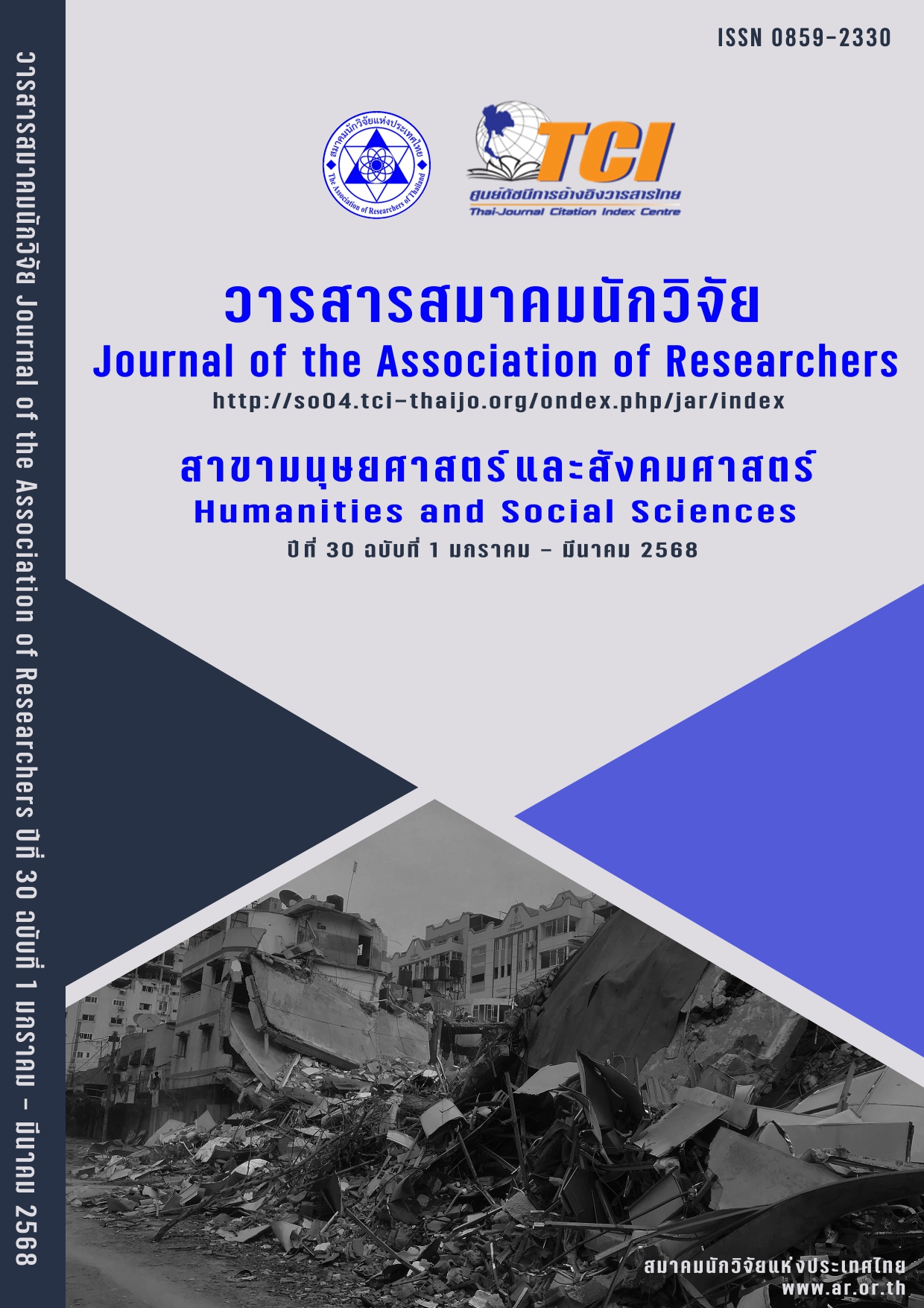The Development of the Instructional Model Based on Buddha’s Teaching Methods to Enhance Concept and Faith in Precept for New Buddhism Novices
Main Article Content
Abstract
The objectives of this research were: 1) to develop an instructional model based on Buddha’s teaching methods to enhance concepts and faith in precepts for new Buddhist novices. 2) to evaluate the effectiveness of the instructional model based on Buddha's teaching methods by: 1) comparing the concepts in Precept for New Buddhist Novices before and after receiving the learning management; 2) studying the development of their behavior in Precept for New Buddhist Novices. 3) study the results of reflection on the value of faith that affects the practice of moral conduct in Precept for New Buddhist Novices after receiving the learning management. 3) to study desirable characteristics of new Buddhist novices. This study was a research and development study using a mixed methods approach based on an embedded design. The samples were nine new Buddhist novices of Yaowachon Tongla Pandee Jitarsa Novice Ordination Project Batch 1/2565 at Samakkeepadungpan Temple. The research instruments included a manual for using the instructional model, lesson plans and units for learning, and tests for evaluating the understanding of precepts among new Buddhist novices. The research instruments included the model handbook and the lesson plans for each unit of the learning management, the test for evaluating the concept of precepts for new Buddhist novices, evaluation forms on the progress of self-practicing precepts for new Buddhist novices, reflective thinking forms on the value of faith leading to the practice of precepts for new Buddhist novices, and evaluation forms on desirable characteristics for new Buddhist novices. The data were analyzed using percentage, mean, standard deviation, and content analysis. The findings of this research found that 1) the instructional model based on Buddha's teaching methods to enhance concept and faith in precepts for new Buddhist novices consisted of 5 important components; 1) principle 2) objectives 3) instructional steps “SDPRQ AETI Model” consisting of 9 stages dividing into 2 periods; 1) learning and teaching in classroom (SDPRQ) consisting of 5 stages; 1) S: Stimulation 2) D: Development 3) P: Practice 4) R: Reflection 5) Q: Quotient and 2) learning and teaching outside classroom (AETI) consisting of 4 stages; 6) A: Aspiration 7) E: Exertion 8) T: Thoughtfulness 9) I: Investigation. 5) The essential conditions for successfully implementing the model were that the model had the highest quality (M= 4.70, S.D. = 0.38). 2) The effectiveness of the instructional model was 1) the concept in the precepts of new Buddhist novices after learning using the instructional model based on Buddha's teaching methods, which was higher than before learning. 2) The progress of self-practicing following the precepts of new Buddhist novices after learning to use the instructional model based on Buddha's teaching methods was continually higher. and 3) after learning using the instructional model based on Buddha's teaching methods, novices could reflect on the value of faith, leading to practicing following relevant precepts that met the criteria. And 3) Desirable characteristics of new Buddhist novices were at the excellent level.
Article Details

This work is licensed under a Creative Commons Attribution-NonCommercial-NoDerivatives 4.0 International License.
บทความที่ปรากฏในวารสารนี้ เป็นความรับผิดชอบของผู้เขียน ซึ่งสมาคมนักวิจัยไม่จำเป็นต้องเห็นด้วยเสมอไป การนำเสนอผลงานวิจัยและบทความในวารสารนี้ไปเผยแพร่สามารถกระทำได้ โดยระบุแหล่งอ้างอิงจาก "วารสารสมาคมนักวิจัย"
References
กันตภณ ชื่นกลิ่นธูป. (2564). การพัฒนาผลสัมฤทธิ์ทางการเรียน เรื่องหลักธรรมทางพระพุทธศาสนา ของนักเรียนชั้นมัธยมศึกษาปีที่ 3 ด้วยการสอนแบบอริยสัจ 4 โดยใช้กรณีตัวอย่าง. หลักสูตรศึกษาศาสตรมหาบัณฑิตสาขาวิชาหลักสูตรและการสอน, บัณฑิตวิทยาลัย มหาวิทยาลัยศิลปากร.
ฐิติวัสส์ สุขป้อม. (2557). การพัฒนารูปแบบการเรียนการสอนตามแนวพุทธวิถีวิธีเพื่อเสริมสร้างคุณลักษณะบัณฑิตที่พึงประสงค์ด้านคุณธรรมจริยธรรมของนักศึกษามหาวิทยาลัยราชภัฏจันทรเกษม. วารสารเกษมบัณฑิต, 15(1), 56-74.
ดารารัตน์ อุทัยพยัคฆ์. (2548). การพัฒนารูปแบบการเรียนการสอนแบบพุทธวิธีเพื่อเสริมสร้างพฤติกรรมการอนุรักษ์สิ่งแวดล้อมของเด็กปฐมวัย. สาขาวิชาการศึกษาปฐมวัย ปริญญาการศึกษาดุษฎีบัณฑิต บัณฑิตวิทยาลัย มหาวิทยาลัยศรีนครินทรวิโรฒ
ทิศนา แขมมณี. (2560). ศาสตร์การสอน: องค์ความรู้เพื่อการจัดกระบวนการเรียนรู้ที่มีประสิทธิภาพ. (พิมพ์ครั้งที่ 8). กรุงเทพฯ: แห่งจุฬาลงกรณ์มหาวิทยาลัย.
พระพรหมคุณาภรณ์ (ป.อ.ปยุตโต). (2550). วิธีคิดตามหลักพุทธธรรม. กรุงเทพฯ: ธรรมสภา
พระปลัดราชันย์ ขวัญเมือง. (2562). การพัฒนารูปแบบการสอนตามแนวคิดทางพระพุทธศาสนาเพื่อส่งเสริมความสามารถในการแก้ปัญหา สำหรับนักเรียนระดับมัธยมศึกษาตอนปลาย. วิทยานิพนธ์ปรัชญาดุษฎีบัณฑิต สาขาหลักสูตรและการสอน มหาวิทยาลัยธุรกิจบัณฑิต.
พระราชวรมุนี (ประยุทธ์ ปยุตฺโต). (2523). พจนานุกรมพุทธศาสตร์. กรุงเทพฯ: มหาจุฬาลงกรณราชวิทยาลัย.
พลพจน์ เชาว์วิวัฒน์. (2564). การพัฒนาชุดฝึกอบรมแบบบูรณาการตามแนวพุทธจิตวิทยาเพื่อเสริมสร้างพฤติกรรมเชิงจริยธรรมด้านจิตสาธารณะสำหรับพนักงานวิสาหกิจขนาดกลาง และขนาดย่อม (SMEs) ในจังหวัดสมุทรปราการ. ปรัชญาดุษฎีบัณฑิต สาขาพุทธจิตวิทยา มหาวิทยาลัยมหาจุฬาลงกรณราชวิทยาลัย.
มาเรียม นิลพันธ์. (2558). วิธีวิจัยทางการศึกษา. พิมพ์ครั้งที่ 8. นครปฐม: ศูนย์วิจัยและพัฒนาการทางการศึกษา คณะศึกษาศาสตร์ มหาวิทยาลัยศิลปากร.
วัชรา เล่าเรียนดี. (2552). รูปแบบและกลยุทธ์การจัดการเรียนรู้ เพื่อพัฒนาทักษะการคิด. พิมพ์ครั้งที่ 4. คณะศึกษาศาสตร์ มหาวิทยาลัยศิลปากร.
สำนักงานคณะกรรมการการศึกษาแห่งชาติ สำนักนายรัฐมนตรี (2545-2559). แผนการศึกษาแห่งชาติ. กรุงเทพฯ: บริษัทพริกหวานกราฟฟิก จำกัด.
Calvo, A., et al. (2000). Models of Teaching, Boston: Allyn and Bacon. Borko, H., Jacobs, J. & Koellner, K. (2010). Contemporary approaches to teacher professional development. In E. Baker, B. McGaw & P. Peterson (Eds.), International encyclopedia of education (pp. 548–555). Oxford.
Kruse. K.(2009). Introduction to Introductional design and the ADDIE model. Retrieved 13 May 2020, from http://attachments.wetpaintserv.us/ptjscRGWeYQx-7LyqXXag74752.
สัมภาษณ์
พระวิสุทธิคณาภรณ์ พระครูธีรธรรมานุยุต พระครูถาวรธรรมวัฒน์ พระครูโพธิธรรมวุฒิพระครูเขมธรรมโฆษิต เมื่อวันที่ 9 เดือนมีนาคม พ.ศ. 2563
Translates in Thai Reference
Chuenglinthup, K. (2021). Development of learning achievement in the subject of Buddhist principles of Mathayom 3 students by teaching the Four Noble Truths using a case study. Master of Education (CURRICULUM AND INSTRUCTION)Department of Curriculum and Instruction, Graduate School, Silpakorn University.
Chaowiwat, P. (2021). Development of an integrated training package based on Buddhist psychology to enhance ethical behavior in public consciousness for employees of small and medium-sized enterprises (SMEs) in Samut Prakan Province. Doctor of Philosophy in Buddhist Psychology, Mahachulalongkornrajavidyalaya University.
Khammanee, T. (2017). Teaching Science: Knowledge for Organizing Effective Learning Processes. (8th ed.). Bangkok: Chulalongkorn University.
Laoriandee, W. (2009). Learning management models and strategies for developing thinking skills. 4th ed. Faculty of Education, Silpakorn University.
Nilphan, M. (2015). Educational Research Methods. 8th ed. Nakhon Pathom: Educational Research and Development Center, Faculty of Education, Silpakorn University.
Office of the National Education Commission, Prime Minister's Office (2002-2016). National Education Plan. Bangkok: Prik Wan Graphic Co., Ltd.
Phra Phromkunaphon (P.A. Payutto). (2007). Ways of thinking according to Buddhist principles. Bangkok: Dharmasapha.
Phra Palat Ratchan Khwanmuang. (2019). Development of a teaching model based on Buddhist concepts to promote problem-solving ability for high school students. Doctor of Philosophy Thesis in Curriculum and Instruction, Dhurakij Pundit University.
Phra Ratchawaramuni (Prayut Payutto). (1980). Dictionary of Buddhism. Bangkok: Mahachulalongkornrajavidyalaya University.
Uthaipayak, D. (2005). Development of Buddhist teaching methods to promote environmental conservation behavior in early childhood children. Department of Early Childhood Education, Doctor of Education, Graduate School, Srinakharinwirot University.
Sukpom, T. (2014). Development of teaching model according to Buddhist method to enhance the desired graduate characteristics in terms of morality and ethics of Chandrakasem Rajabhat University students. Kasembundit Journal, 15(1), 56-74.
interview
Phra Wisutthikhanaphon, Phra Khru Thiradhammanuyut, Phra Khru Thawarathamwat, Phra Khru Phothithamwuthi, and Phra Khru Khemthammakhosit interviewed on March 9, 2020.


